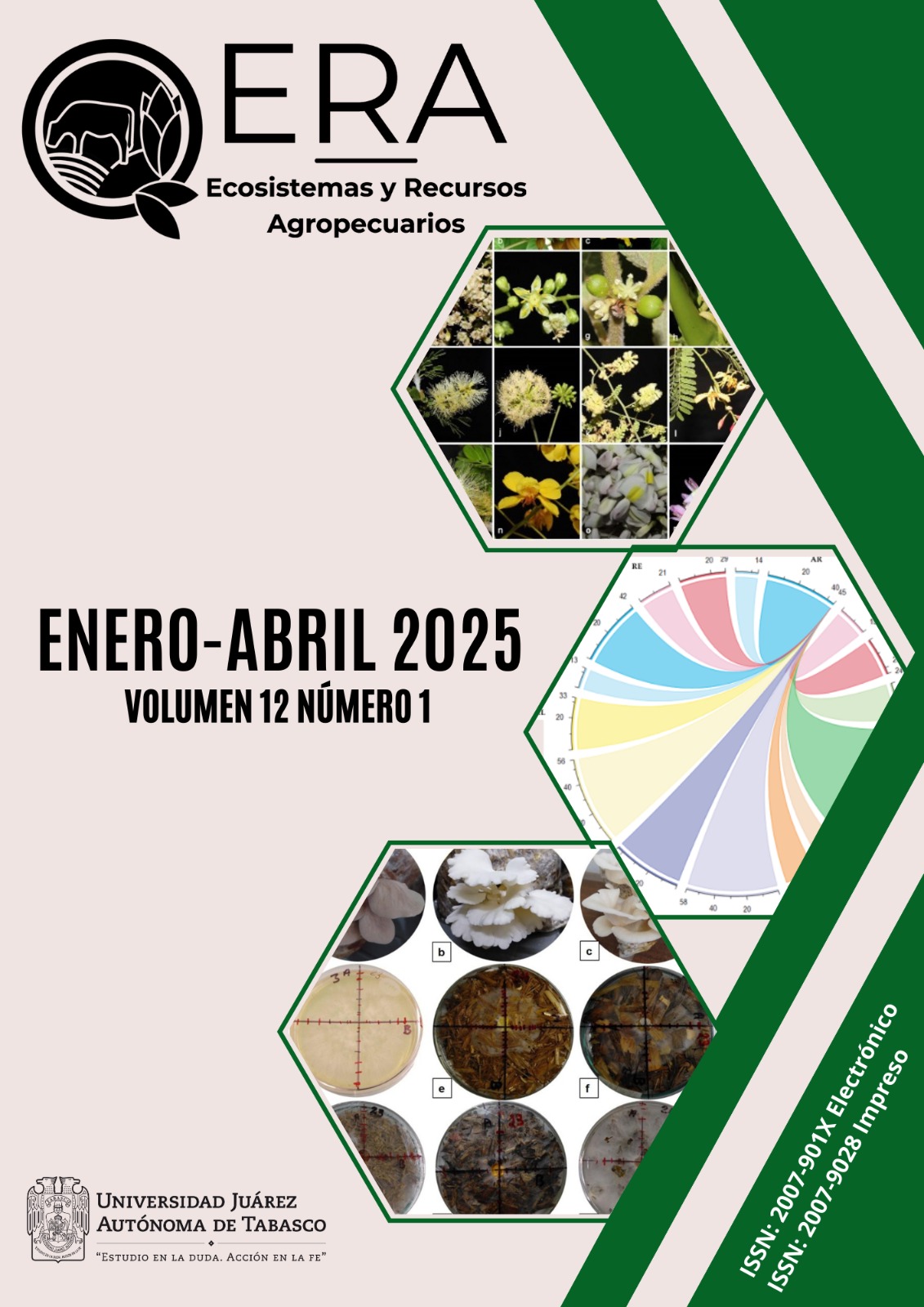Emisión de gases de efecto invernadero por incendios forestales en tres comunidades arbóreas de Michoacán
DOI:
https://doi.org/10.19136/era.a12n1.4184Palabras clave:
Comportamiento del fuego, ecuaciones de estimación, factor de eficiencia de combustión, fases de combustión, quema de acículasResumen
Los incendios forestales consumen grandes cantidades de combustible forestal y emiten gases de efecto invernadero a la atmosfera, principalmente de CO2 y CO. El objetivo de este trabajo fue calcular las emisiones en quemas de la capa de hojarasca, así como las emisiones considerando todos los estratos vegetales en la Reserva de la Biosfera Mariposa Monarca que nos indiquen si las comunidades arbóreas corresponden o no a una misma cama de combustible. Para lo cual se quemó la capa de hojarasca de las comunidades arbóreas de oyamel, pino-oyamel y pino-encino. También se usó el programa CONSUME para calcular las emisiones de todos los estratos. Se obtuvo que la capa de hojarasca con menor emisión total correspondió a oyamel con 46 gr kg-1 respecto a los 647 y 437 gr kg-1 registrados en pino-oyamel y pino-encino, respectivamente, (p < 0.05). Se obtuvieron modelos de predicción de emisión de CO2, CO, CH4, NO2 y NOX que explicaron el 74% de las emisiones generadas por las quemas. Con CONSUME se obtuvo mayor emisión en la comunidad de oyamel. La emisión presentó una correlación de 85% con el consumo, con 43% más de consumo en combustible de baja humedad respecto a los combustibles con alta humedad. Las comunidades integradas por pino no presentaron variación de emisión, pero la elevada carga de combustibles influyó en una alta emisión, por lo que la reducción de la carga de combustibles reduciría significativamente la presencia y potencial de un incendio forestal, así como las emisiones.
Descargas
Referencias
Akagi SK, Burling IR, Mendoza A, Johnson TJ, Cameron M, Griffith DWT, Paton-Walsh C, Weise DR, Reardon J, Yokelson RJ (2014) Field measurements of trace gases emitted by prescribed fires in southeastern US pine forests using an open-path FTIR system. Atmospheric Chemistry and Physics 14(1): 199-215. https://doi.org/10.5194/acp-14-199-2014
Akagi SK, Yokelson RJ, Wiedinmyer C, Alvarado MJ, Reid JS, Karl T, Crounse JD, Wennberg PO (2011) Emission factors for open and domestic biomass burning for use in atmospheric models. Atmospheric Chemistry and Physics 11(9): 4039-4072. https://doi.org/10.5194/acp-11-4039-2011
Bentley PD, Penman TD (2017) Is there an inherent conflict in managing fire for people and conservation? International Journals of Wildland Fire 26: 455-468. https://doi.org/10.1071/WF16150
Cascio WE (2018) Wildland fire smoke and human health. The Science of the Total Environment 624: 586. https://doi.org/10.1016/J.SCITOTENV.2017.12.086
Cofer WR, Levine JS, Winstead EL, Stocks BJ, Cahoon DR, Pinto JP (1993) Trace gas emissions from tropical biomass fires: Yucatan Peninsula, Mexico. Atmospheric Environment Part A General Topics 27(12): 1903-1907. https://doi.org/10.1016/0960-1686(93)90295-A
Corona-Núñez RO, Li F, Campo JE (2020) Fires Represent an Important Source of Carbon Emissions in Mexico. Global Biogeochem Cycles 34: e2020GB006815. https://doi.org/10.1029/2020GB006815
Drury SA, Larkin N (Sim), Strand TT, Huang S, Strenfel SJ, Banwell EM, O’Brien TE, Raffuse SM (2014) Intercomparison of fire size, fuel loading, fuel consumption, and smoke emissions estimates on the 2006 tripod fire, Washington, USA. Fire Ecology 10(1): 56-83. https://doi.org/10.4996/fireecology.1001056
Fernandes PM, Loureiro C (2013) Fine fuels consumption and CO2 emissions from surface fire experiments in maritime pine stands in northern Portugal. Forest Ecology and Management 291: 344-356. https://doi.org/10.1016/j.foreco.2012.11.037
Fernández-Alonso JM, Vega JA, Jiménez E, Ruiz-González AD, Álvarez-González JG (2017) Spatially modeling wildland fire severity in pine forests of Galicia, Spain. European Journal of Forest Research 136(1): 105-121. https://doi.org/10.1007/s10342-016-1012-5
Hao WM, Larkin NK (2014) Wildland fire emissions, carbon, and climate: Wildland fire detection and burned area in the United States. Forest Ecology and Management 317: 20-25. https://doi.org/10.1016/J.FORECO.2013.09.029
IPCC (2003) Good practice guidance for land use, land-use change and forestry. Institute for Global Environmental Strategies. Kanagawa, Japan. 1170 p.
Kasischke ES, Hoy EE (2012) Controls on carbon consumption during Alaskan wildland fires. Global Changes Biology 18(1): 685-699. https://doi.org/10.1111/J.1365-2486.2011.02573.X
Kreye JK, Brewer NW, Morgan P, Varner JM, Smith AMS, Hoffman CM, Ottmar RD (2014) Fire behavior in masticated fuels: A review. Forest Ecology and Management 314: 193-207. https://doi.org/10.1016/j.foreco.2013.11.035
Miesel J, Reiner A, Ewell C, Maestrini B, Dickinson M (2018) Quantifying changes in total and pyrogenic carbon stocks across fire severity gradients using active wildfire incidents. Frontiers in Earth Science 6: 1. https://doi.org/10.3389/feart.2018.00041
Morfín-Ríos JE, Jardel-Peláez EJ, Alvarado-Celestino E, Michel-Fuentes JM (2012) Caracterización y cuantificación de combustibles forestales. Comisión Nacional Forestal-Universidad de Guadalajara. Guadalajara, Jalisco, México. 113p.
O’Brien JJ, Hiers JK, Varner JM, Hoffman CM, Dickinson MB, Michaletz ST, Loudermilk EL, Butler BW (2018) Advances in mechanistic approaches to quantifying biophysical fire effects. Current Forestry Reports 4: 161-177. https://doi.org/10.1007/S40725-018-0082-7/FIGURES/7
Ottmar RD (2014) Wildland fire emissions, carbon, and climate: Modeling fuel consumption. Forest Ecology and Management 317: 41-50. https://doi.org/10.1016/J.FORECO.2013.06.010
Ottmar RD, Sandberg DV, Riccardi CL, Prichard SJ (2007) An overview of the fuel characteristic classification system-quantifying, classifying, and creating fuelbeds for resource planning. Canadian Journal of Forest Research 2393(37): 2383-2393. https://doi.org/https://doi.org/10.1139/X07-07
Paton-Walsh C, Smith TEL, Young EL, Griffith DWT, Guérette A (2014) New emission factors for Australian vegetation fires measured using open-path Fourier transform infrared spectroscopy - Part 1: Methods and Australian temperate forest fires. Atmospheric Chemistry and Physics 14(20): 11313-11333. https://doi.org/10.5194/ACP-14-11313-2014
Pokhrel RP, Gordon J, Fiddler MN, Bililign S (2021) Determination of emission factors of pollutants from biomass burning of african fuels in laboratory measurements. Journal of Geophysical Research: Atmospheres 126: e2021JD034731. https://doi.org/10.1029/2021JD034731
Prichard SJ, Kennedy MC, Wright CS, Cronan JB, Ottmar RD (2017) Predicting forest floor and woody fuel consumption from prescribed burns in southern and western pine ecosystems of the United States. Data Brief 15: 742-746. https://doi.org/10.1016/J.DIB.2017.10.029
Ramírez MI, Benet D, Pérez-Salicrup DR, Skutsch M, Venegas-Pérez Y (2019) Community participation for carbon measurement in forests of the Monarch Butterfly Biosphere Reserve, Mexico. Revista Chapingo Serie Ciencias Forestales y del Ambiente 25(3): 333-352. https://doi.org/10.5154/R.RCHSCFA.2018.06.044
Rappold AG, Reyes J, Pouliot G, Cascio WE, Diaz-Sanchez D (2017) Community vulnerability to health impacts from wildland fire smoke exposure. Environmental Science & Technology 51(12): 6674. https://doi.org/10.1021/ACS.EST.6B06200
Reid CE, Brauer M, Johnston FH, Jerrett M, Balmes JR, Elliott CT (2016) Critical review of health impacts of wildfire smoke exposure. Environmental Health Perspectives 124(9): 1334. https://doi.org/10.1289/EHP.1409277
Rodríguez Trejo DA, Pulido Luna JA, Martínez Muñoz P, Martínez Lara PJ, Monjarás Vega NA (2018) Análisis comparativo de quemas prescritas aplicadas a encinares tropicales. Agrociencia 52(6): 783-801
Rodríguez-Trejo DA, Martínez-Muñoz P, Pulido-Luna JA, Martínez-Lara PJ, Cruz-López JD (2020) Combustibles, comportamiento del fuego y emisiones en un pastizal y una sabana artificiales en Chiapas. Revista de Biología Tropical 68(2): 641-654. https://doi.org/10.15517/rbt.v68i2.33954
Rstudio Team (2020) RStudio: Integrated Development Environmental for R (Version 4.0.3.). RStudio, PBC, Boston, MA.
Ruiz-Corzo R, Aryal DR, Venegas-Sandoval A, Jerez-Ramírez DO, Fernández-Zúñiga KS, Lopez-Cruz S del C, López-Hernández JC, Peña-Álvarez B, Velázquez-Sanabria CA (2022) Dinámica temporal de combustibles forestales y efecto del incendio en Cerro Nambiyugua, Chiapas, México. Ecosistemas y Recursos Agropecuarios 9(2): e3253. https://doi.org/10.19136/era.a9n2.3253
Sikkink PG, Jain TB, Reardon J, Heinsch FA, Keane RE, Butler B, Baggett LC (2017) Effect of particle aging on chemical characteristics, smoldering, and fire behavior mixed-conifer masticated fuel. Forest Ecology and Management 405: 150-165. http://dx.doi.org/10.1016/j.foreco.2017.09.008
Russell-Smith J, Murphy BP, Meyer CP (Mick), Cook GD, Maier S, Edwards AC, Schatz J, Peter B (2009) Improving estimates of savanna burning emissions for greenhouse accounting in northern Australia: limitations, challenges, applications. International Journal of Wildland Fire 18(1): 1-18. https://doi.org/10.1071/WF08009
Urbanski S (2014) Wildland fire emissions, carbon, and climate: Emission factors. For Ecol Manage 317: 51-60. https://doi.org/10.1016/j.foreco.2013.05.045
Yokelson RJ, Burling IR, Gilman JB, Warneke C, Stockwell CE, De Gouw J, Akagi SK, Urbanski SP, Veres P, Roberts JM, Kuster WC, Reardon J, Griffith DWT, Johnson TJ, Hosseini S, Miller JW, Cocker III DR, Jung H, Weise DR (2013) Coupling field and laboratory measurements to estimate the emission factors of identified and unidentified trace gases for prescribed fires. Atmos Chem Phys 13(1): 89-116. https://doi.org/10.5194/acp-13-89-2013
Yokelson RJ, Burling IR, Urbanski SP, Atlas EL, Adachi K, Buseck PR, Wiedinmyer C, Akagi SK, Toohey DW, Wold CE (2011) Trace gas and particle emissions from open biomass burning in Mexico. Atmospheric Chemistry and Physics 11(14): 6787-6808. https://doi.org/10.5194/ACP-11-6787-2011
Yokelson RJ, Crounse JD, DeCarlo PF, Karl T, Urbanski S, Atlas E, Campos T, Shinozuka Y, Kapustin V, Clarke AD, Weinheimer A, Knapp DJ, Montzka DD, Holloway J, Weibring P, Flocke F, Zheng W, Toohey D, Wennberg PO, Wiedinmyer C, Mauldin L, Fried A, Richter D, Walega J, Jimenez JL, Adachi K, Buseck PR, Hall SR, Shetter R (2009) Emissions from biomass burning in the Yucatan. Atmospheric Chemistry and Physics 9(15): 5785-5812. https://doi.org/10.5194/ACP-9-5785-2009
Yokelson RJ, Urbanski SP, Atlas EL, Toohey DW, Alvarado EC, Crounse JD, Wennberg PO, Fisher ME, Wold CE, Campos TL, Adachi K, Buseck PR, Hao WM (2007) Emissions from forest fires near Mexico City. Atmospheric Chemistry and Physics 7(21): 5569-5584. https://doi.org/10.5194/acp-7-5569-2007
Publicado
Número
Sección
Licencia
Derechos de autor 2025 Ecosistemas y Recursos Agropecuarios

Esta obra está bajo una licencia internacional Creative Commons Atribución-NoComercial-SinDerivadas 4.0.
1. Política propuesta para revistas de acceso abierto
Los autores/as que publiquen en esta revista aceptan las siguientes condiciones:
1. Los autores/as conservan los derechos de autor y ceden a la revista el derecho de la primera publicación, con el trabajo registrado con la Licencia CC BY-NC-ND 4.0 Creative Commons Attribution-NonCommercial-NoDerivatives 4.0 Internacional de Creative Commons, que permite a terceros utilizar lo publicado siempre que mencionen la autoría del trabajo y a la primera publicación en esta revista.
2. Los autores/as pueden realizar otros acuerdos contractuales independientes y adicionales para la distribución no exclusiva de la versión del artículo publicado en esta revista (p. ej., incluirlo en un repositorio institucional o publicarlo en un libro) siempre que indiquen claramente que el trabajo se publicó por primera vez en esta revista.
3. Se permite y recomienda a los autores/as a publicar su trabajo en Internet (por ejemplo en páginas institucionales o personales) antes y durante el proceso de revisión y publicación, ya que puede conducir a intercambios productivos y a una mayor y más rápida difusión del trabajo publicado (vea The Effect of Open Access).
![]()
This work is licensed under CC BY-NC-ND 4.0


